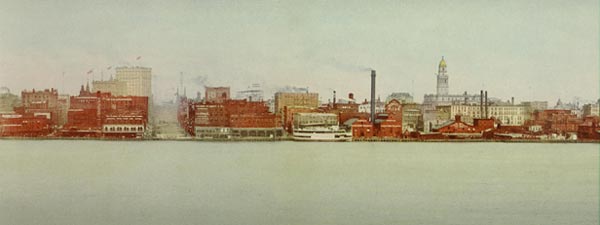June 2001

This is the center section of a panoramic color lithograph of the Detroit skyline and harbor from the Detroit River, 1901. (37.102.71)
Photographer to the World--The Detroit Publishing Company
The canals of Venice. The Casbah. The Colorado Rockies. In the days before television, Americans longed to see exotic sights. The photographers of the Detroit Publishing Company, founded in 1895, brought the world to everyone's living room.
Detroit Publishing Company History
For nearly 30 years from 1895 to 1924, the Detroit Publishing Company produced thousands of images of cities, landscapes, exotic lands, hotels, companies, and art work, which they sold as photographic prints, panoramas, postcards, lantern slides, souvenirs and advertising art. Incorporated in 1895 as the Photochrom (pronounced "photochrome") Company in Detroit, Michigan, it was known until 1905 as the Detroit Photographic Company, and then the Detroit Publishing Company
In the 1890s, photographer Edwin H. Husher had assembled financial backing to establish the Photochrom Company in Detroit. His backers included the Photoglob (pronounced "photoglobe") Company of Switzerland, and Detroiter William A. Livingstone, son of shipping, banking, and publishing magnate William Livingstone, Jr.
They obtained the North American rights to an astounding new photolithographic process called Photochrom from the Photoglob Company of Zurich. This process produced color lithograph prints that looked like color photographs. Since color print photography did not then exist, this method gave the company a significant advantage over its competitors.
In late 1897, pioneer American photographer William H. Jackson joined the company, adding 10,000 of his glass-plate negatives to the company's assets. In his early years with the company, Jackson traveled throughout the United States, Canada, and the Caribbean, taking his own photographs and purchasing the photographic stock of local photographers.
At its peak, the company drew upon 40,000 negatives for its publishing effort and had sales of seven million prints annually. Traveling salesmen, mail order catalogues, and a few retail stores aggressively sold the company's products.
Sales declined during the First World War and continued to drop as competitors using newer and less labor-intensive production methods entered the business. In 1924 the company declared bankruptcy.
The Detroit Publishing Company at The Henry Ford
The Henry Ford acquired the remaining Detroit Publishing Company materials in 1937 from the estate of Robert B. Livingstone. At the insistence of William H. Jackson's son, Clarence, a decade later the museum donated the negatives to the Colorado Historical Society but kept the prints. The Colorado Historical Society retained the Western views but donated the negatives of Eastern United States and foreign views to the Library of Congress in Washington, D.C.
The photographs in the museum's collection are contact prints made by the company from the original glass-plate negatives. They often contain written information about the topic, instructions concerning reproduction methods, and retouching marks.
To see a small sampling of the more than 50,000 photographs and lithographs in the Detroit Publishing Company collection, be sure to visit "Photographer to the World--The Detroit Publishing Company", an exhibit featuring over 100 prints and photographs on display in Henry Ford Museum from June 1, 2001 through January 6, 2002. This exhibit is part of the Detroit 300 celebration.

